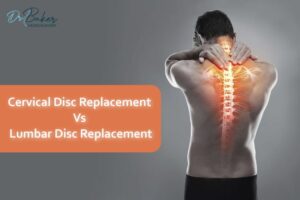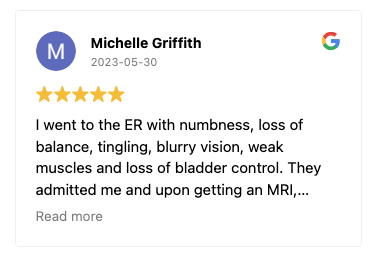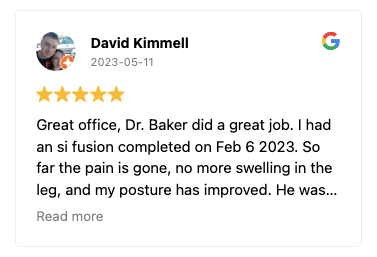Differences Between Cervical Disc Replacement and Lumbar Disc Replacement

Artificial Disc Replacement Surgery
Artificial disc replacement surgery is a surgical procedure in which a damaged or worn-out intervertebral disc in the spine is replaced with an artificial disc. The artificial disc’s purpose is to mimic a natural disc’s movement and function. Moreover, it is made of various materials such as metal, plastic, or a combination of both.
The Disc Replacement surgery aims to relieve pain and improve function in the affected spinal area. It is usually an alternative to spinal fusion, another type of surgery used to treat damaged or worn-out discs.
Cervical Disc Replacement Surgery vs. Lumbar Disc Replacement Surgery
Cervical disc replacement and lumbar disc replacement may seem identical, but they are quite different. Here are the key differences that you can find between these two surgical procedures.
Location
- Cervical disc replacement surgery is performed on the spine’s cervical (neck) region.
- Lumbar disc replacement surgery is performed on the spine’s lumbar (lower back) region.
Procedure
- In cervical disc replacement surgery, surgeons remove the problematic disc in the cervical spine and then replace it with the artificial one.
- In lumbar disc replacement surgery, surgeons remove the problematic disc in the lumbar spine and then replace it with the artificial one.
Recovery Time
- Recovery time for cervical disc replacement surgery is typically shorter than for lumbar disc replacement surgery.
- Patients who undergo cervical disc replacement surgery may be able to resume their normal activities and job in a matter of weeks. In contrast, those who undergo lumbar disc replacement surgery may require several weeks or even months to recover.
Risks and Complications
- Risks and complications for cervical and lumbar disc replacement surgery are similar. Still, the risks and complications may differ for each patient depending on their age, health, and other factors.
- Both types of surgery carry risks such as bleeding, infection, and adverse reactions to anesthesia.
- There is a risk that the artificial disc may fail, leading to the need for revision surgery.
- Some patients may experience nerve damage or persistent pain following the surgery.
Effectiveness
- It has been demonstrated that patients with damaged discs can get pain relief and improved function following cervical and lumbar disc replacement surgery.
- Patients with degenerative disc disease-related persistent pain and impairment may benefit from any or both types of surgery.
- Cervical disc replacement surgery may result in better outcomes than lumbar disc replacement surgery, according to some studies, although further study is required to substantiate these claims.
Benefits of Artificial Disc Replacement Surgery
In comparison to conventional spinal fusion surgery, which involves joining two vertebrae to relieve back pain, artificial disc replacement surgery, also known as spinal disc replacement, has several potential advantages. The following are some advantages of artificial disc replacement surgery:
Preservation of Motion
Artificial disc replacement permits a more natural range of motion in the spine than spinal fusion, which restricts movement in the affected area.
Decreased Likelihood of Adjacent-level Degeneration
Spinal fusion can stress nearby vertebrae, which can induce degeneration and pain. Artificial disc replacement may lower this risk by dispersing stress more evenly along the spine.
Quick Recovery Time
Recovery times following artificial disc replacement surgery may be quicker than those following spinal fusion, allowing patients to resume regular activities more rapidly.
Better Pain Relief
Patients with degenerative disc disease and other back pain-causing disorders may find that artificial disc replacement surgery significantly reduces their pain.
Only some people are candidates for artificial disc replacement. The best course of action depends on the situation, the patient’s medical history, and the surgeon’s experience level.
Precautions to Follow After Disc Replacement Surgery
It’s crucial to adhere to your doctor’s and physical therapist’s advice if you want to promote adequate healing following disc replacement surgery. You should act on the following advice as the preventive measures after disc replacement surgery.
- Resting and refraining from physically demanding activities for a while to restore mobility and strength through physical therapy
- Managing pain to reduce discomfort using a collar or brace to preserve the surgical site.
- Continual check-ups with your surgeon to assess your progress.
- Avoid motions like twisting, bending, and heavy lifting that strain your spine.
- Maintaining a healthy lifestyle is also crucial since it can help with healing. This includes eating a balanced diet, exercising regularly, and abstaining from substances like alcohol and smoking.
Dr. Abdul Baker - An Expert in Disc Replacement Surgery
Every neurosurgery has its complications; thus, a patient must choose the best neurosurgeon for himself. Dr. Abdul Baker is one of the most experienced and qualified neurosurgeons in Texas, treating patients for more than 16 years. People in Sherman, Plano, and nearby areas trust him for every kind of neurosurgery due to his surgical procedures’ 100% success rate. You may visit him if you need any consultancy or treatment regarding your brain and spine disorders.


Dr. Baker specializes in neurosurgery, neurosurgical spine surgery, neurotrauma, brain tumors, spinal tumors, and peripheral nerve damage treatment.









